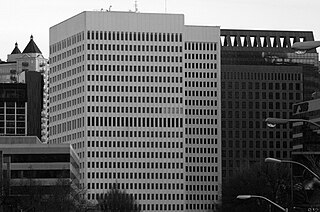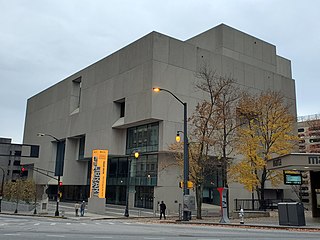
The architecture of Atlanta is marked by a confluence of classical, modernist, post-modernist, and contemporary architectural styles. Due to the Battle of Atlanta and the subsequent fire in 1864, the city's architecture retains almost no traces of its Antebellum past. Instead, Atlanta's status as a largely post-modern American city is reflected in its architecture, as the city has often been the earliest, if not the first, to showcase new architectural concepts. However, Atlanta's embrace of modernism has translated into an ambivalence toward architectural preservation, resulting in the destruction of architectural masterpieces, including the Commercial-style Equitable Building, the Beaux-Arts style Terminal Station, and the Classical Carnegie Library. The city's cultural icon, the Neo-Moorish Fox Theatre, would have met the same fate had it not been for a grassroots effort to save it in the mid-1970s.

The Atlanta–Fulton Public Library System is a network of public libraries serving the City of Atlanta and Fulton County, both in the U.S. state of Georgia. The system is administered by Fulton County. The system is composed of the Atlanta Central Library in Downtown Atlanta, which serves as the library headquarters, as well as the Auburn Avenue Research Library on African American Culture and History, and 33 branch libraries.

Atlantic Station is a neighborhood on the northwestern edge of Midtown Atlanta, Georgia, United States comprising a retail district, office space, condominiums, townhomes and apartment buildings. First planned in the mid-1990s and officially opened in 2005, the neighborhood's 138 acres are located on the former brownfield site of the Atlantic Steel mill.

The Governor's Mansion is the official home of the governor of the U.S. state of Georgia. The mansion is located at 391 West Paces Ferry Road NW, in the Tuxedo Park neighborhood of the affluent Buckhead district of Atlanta.

The Fairlie–Poplar Historic District is part of the central business district in downtown Atlanta. It is named for the two streets that cross at its center, northeast-only Fairlie and southeast-only Poplar. Fairlie–Poplar is immediately north of Five Points, the definitive center point and longtime commercial heart of Atlanta. It is roughly bounded on the southwest by Marietta Street, on the southeast by Peachtree Street or Park Place, on the northeast by Luckie Street or Williams Street, and on the northwest by Cone Street or Spring Street. It has smaller city blocks than the rest of the city, and the streets run at a 40° diagonal.

1180 Peachtree, commonly known as the Symphony Tower, is a 41-story skyscraper located at 1180 Peachtree Street in the Midtown district of Atlanta, Georgia, United States. Rising to a height of approximately 657 feet (200 m), the building includes office and retail space in its 624,996 sq ft (58,064 m2) of floor area as well as a 1,200 space parking deck. Construction was completed in 2006.

Peachtree Center is a district located in Downtown Atlanta, Georgia. Most of the structures that make up the district were designed by Atlanta architect John C. Portman, Jr. A defining feature of the Peachtree Center is a network of enclosed pedestrian sky bridges suspended above the street-level, which have garnered criticism for discouraging pedestrian street life. The district is served by the Peachtree Center MARTA station, providing access to rapid transit.

Woodruff Park, named for Robert W. Woodruff, is located in the heart of Downtown Atlanta, Georgia. The park's 6 acres (2.4 ha) are north of Edgewood Ave, between Peachtree Street NE and Park Place NE. The park includes a fountain, a performance pavilion, and several monuments.

Peachtree Center is an underground train station on the Red and Gold lines of the Metropolitan Atlanta Rapid Transit Authority (MARTA) rail system. It is the deepest station in the MARTA rail system, at 120 feet (37 m) below Peachtree Street. It serves the Peachtree Center neighborhood of downtown Atlanta, and is the first station north-northeast of the rail system hub at Five Points. Peachtree Center is one of the busiest stations on the Red/Gold Lines, handling over 15,000 people per weekday.

The Andrew Young School of Policy Studies at Georgia State University houses the Criminal Justice & Criminology, Economics, School of Social Work, Urban Studies and Public Management & Policy departments. Georgia State University is the largest university in the state of Georgia.

The Hotel District is a neighborhood in Downtown Atlanta, Georgia, United States. The district's name is derived from it being the home to many hotels, one of them being the famous Westin Peachtree Plaza Hotel. The Hotel District is generally considered to be bounded by the Downtown Connector to the east, Five Points to the south, Centennial Olympic Park to the west, and Midtown to the north. The district's primary thoroughfare is Peachtree Street, which contains most of the restaurants, hotels, and office buildings. The intersection of Andrew Young International Boulevard and Peachtree Street forms the heart of the district.

The Museum of Design Atlanta (MODA) is a design museum located in Atlanta, Georgia, United States. It is billed as “the only museum in the Southeast devoted exclusively to the study and celebration of all things design."

Colony Square is a mixed-use development and sub-district in Midtown Atlanta, Georgia, located on Peachtree Street in between 14th and 15th Streets. The oldest high-rise development in Midtown, the sub-district was built between 1969 and 1975, with Henri Jova of Jova/Daniels/Busby serving as principal architect. It was the first mixed-use development in the Southeast.

The Peachtree Arcade was a shopping arcade in downtown Atlanta, Georgia, United States. The building, modeled after the Arcade in Cleveland, was designed by Atlanta-based architect A. Ten Eyck Brown and was located between Peachtree Street and Broad Street near Five Points. Construction began in 1917 and was completed the following year. Located in the city's central business district, it was very popular with citizens, functioning as an unofficial "civic center" for the city. However, by the 1960s, the arcade was facing increased competition from shopping malls located in Atlanta's suburbs, and in 1964, the building was demolished to make way for the First National Bank Building, a skyscraper that, at the time of its construction, was the tallest building in both Atlanta and the southeastern United States. In 1993, the American Institute of Architects named the building as one of Atlanta's most notable landmarks to have been destroyed.

The Hotel Aragon was a six-story, 125-room hotel at 169 Peachtree Street NE, at the southeast corner of Ellis Street in Atlanta, in what is today the Peachtree Center area of downtown. It was a major addition to the city's hotel capacity at its completion in 1892, cost $250,000, and was built and owned by George Washington Collier. It was the only major hotel in the city not adjacent to Union Station. A 1902 guidebook describes the Aragon as one of three first-class hotels in the city, together with the Kimball House and the Majestic Hotel.

The Connally Building is located at 54 Peachtree Street in Downtown Atlanta, adjacent to the Underground Atlanta retail center. It is a work of architect William Lee Stoddart, completed in 1916. The building has been so extensively renovated that it bears little resemblance to the original design, other than the terra cotta façade on the lower stories. This was originally a six-story office building with a terracotta facade, which replaced an earlier Connally Building on the site. In 1990, eleven stories were added and it was converted into a hotel. It has operated under the names Howard Johnson Plaza Suites, University Place at Underground, The Suite Hotel at the Underground, and most recently it became a Fairfield Inn & Suites.

The Atlanta Central Library in Downtown Atlanta is the main library and headquarters of the Atlanta–Fulton Public Library System. The library, built from 1977 to 1980, has a Brutalist design by architect Marcel Breuer – his last work, and his only work in Atlanta. The building was partially renovated in 2002, and a complete renovation took place from 2018 to 2021, following a 2016 vote against demolishing the structure.
Henri Vatable Jova (1919-2014) was an American architect and preservationist. With Stanley Daniels and John Busby, he founded Jova/Daniels/Busby, a multidisciplinary design firm based in Atlanta, Georgia, which designed several notable projects in Atlanta and throughout the Southeast from 1966 to 2013. Jova is noted for his pioneering support of mixed-use development and interest in the development of Midtown Atlanta.

The Carnegie Building is a historic building located at 141 Carnegie Way in downtown Atlanta, Georgia, United States. Built in 1925 as the Wynne-Claughton Building, the 12-story building was designed by architect G. Lloyd Preacher. It was designated an Atlanta Historic Building in 1990 and was added to the National Register of Historic Places in 2012.

Hardy Ivy Park is a pocket park in downtown Atlanta, Georgia, United States.





















